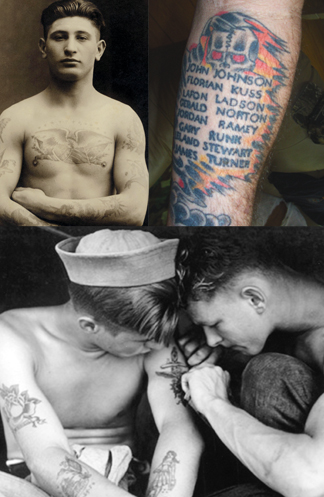THE TRADITION IS A MAINSTAY IN AMERICAN MILITARY HISTORY

While anthropologists cannot pinpoint one reason tattooing began or held fast over the course of humanity, one reason tattooing persists is to signify a warrior. The tradition of tattooing is a mainstay in American military history, from the Revolution to today.
The age-old practice of tattooing can be found on mummies dating as far back as 4000 B.C. Cultural anthropologists attribute the spread of tattooing or body-marking culture to a variety of human traits, ranging from religion to magic to experience and memory.
Outside of religious or ancient ceremonial trends—especially among tribal people worldwide—the connection of the body with patriotic sentiments has, for centuries, been a motivating factor in perpetuating the art of tattoo among warriors. Furthermore, some anthropologists argue that early tattooing was a form of therapy.
“Tattoos and other permanent forms of body modification have been paramount in establishing the status and reputation of warriors for hundreds, if not thousands, of years,” Lars Krutak, a tattoo anthropologist and the host of Discovery Channel’s Tattoo Hunter, told Medium’s “War is Boring” blog in 2014.
Romans & Tribal Markings
In Western culture, tattoos find roots in the Roman Empire. Roman soldiers were tattooed with permanent dots—the mark of SPQR, or Senatus Populusque Romanus—and used as a means of identification and membership in a certain unit.
The Greek word Stizein meant tattoo, and it evolved into the Latin word Stigma meaning a mark or brand. Typically, tattooing was associated with lower classes (criminals, slaves and gladiators) as well as Thracian (Southeastern Indo-European tribe) infantry.
Additionally, tribal warriors of the British Isles embraced the practice of tattooing. Picti people of Caledonia (now Scotland) were known as “the Painted People” because of their tattoos. Celts were known to paint their bodies with spiral motifs—recognized as Celtic knots today. Some American tribes affiliate certain “paint”—body paint, rather than puncture tattooing—with success in war.
Maori tribes of New Zealand have specific tattoo patterns and placement—known as moko—that tell of the wearer’s ancestry and social standing. Maori warriors would behead slaves and tattoo the heads in order to barter for weapons and ammunition from visiting Europeans during the 1700s.
“Use of paint during warfare is very common throughout North America and Australia,” wrote Wilfrid Dyson Hambly in his 1925 book The History of Tattooing. “The desire to impress one’s foes may be uppermost in the case of an advancing army of Indians or Australians who have used the red war paint very freely.”
Throughout Gallipoli (Turkey), Malta and France, soldiers and sailors sported markings. But the sweep of Christianity stifled tattooing in much of the Western world when, in 787 A.D., Pope Hadrian I outlawed tattooing.
Resurgence in Western Culture
In the 18th century, at the height of British colonial exploration, Capt. James Cook’s expeditions to the Far East resulted in a renewed fascination with the age-old practice of body marking. Sailors returned with permanent reminders of their travels and marks of seaward superstition.
The use of tattoos as identification continued, spreading to sailors in America. During the American Revolution, sailors’ American citizenship papers were often disregarded by British Navy ships—destroyed in some cases—so seamen tattooed their identification information as a way to avoid being illegally recruited by the British navy.
The 19th century British army commander Frederick Roberts encouraged tattoos on troops, saying: “Every officer in the British army should be tattooed with his regimental crest. Not only does this encourage esprit de corps but also assists in the identification of casualties.” (Among many campaigns, Roberts served in Afghanistan during the Second Anglo-Afghan War in 1878.)
Two prominent tattoo artists of the 19th century—Tom Riley and Sutherland Macdonald—both served in the British armed forces. Riley fought with the army in the Second Boer War in South Africa from 1899-1902, as well as Sudan, and Macdonald also served in the British army in the 1880s.
Around the same time, British sailor George Burchett learned the art of tattooing. He joined the navy at 12 years old and, after his service and some years travelling the world, Burchett opened a tattoo parlor in England, and trained under Riley and McDonald. He eventually became known as the King of Tattooists—allegedly tattooing members of the upper class as well as royalty.
Migration to the U.S.
German immigrant Martin Hildebrandt is believed to have opened the first tattoo shop in New York City in 1846. He travelled the country tattooing Civil War soldiers. Civil War veteran Wilbur F. Hinman wrote in his novel Corporal Si Klegg and His Pard: “Every regiment had its tattooers, with outfits of needles and India-ink, who for a consideration decorated the limbs and bodies of their comrades with flags, muskets, cannons, sabers and an infinite variety of patriotic emblems and warlike and grotesque devices.” Hinman served with the Ohio 65th Volunteer Infantry. This trend of tattooing military servicemembers persisted. It’s said that even Smedley Butler sported a tattoo of the Marine Corps emblem.
“Interesting cases of present-day employment of tattooing to express social solidarity are common enough among soldiers,” Hambly wrote.
“Military men not infrequently mark themselves with something which shows allegiance to their profession, for example, the date of a battle, cross-guns, a flag, a cannon, or a pyramid of bullets. Naval men prefer a ship or an anchor, and sometimes the marking does not merely connect the wearer with some particular army, but further identifies him with a certain corps. Thus a cavalryman tattooed a horse on himself.”
Hambly claims in his book that at the time of publication (1925) some 90% of U.S. Navy sailors were tattooed.
The popularity of tattooing in port towns throughout the U.S. stirred the tattoo business. In 1918, August Coleman—“Cap” as he was known among his clients—opened a tattoo parlor in Norfolk, Va., making a living by tattooing sailors. Franklin Paul Rogers, who became known for his development of modern tattooing machinery, studied under Coleman from 1945-50.
As a child, Rogers met a Spanish-American War veteran who was heavily tattooed, and the future father of American tattooing got his first tattoo at 21 in 1926. He is best known for his “old-school” tattooing style, modeled by such current tattoo artists as Ed Hardy.
Norman Keith Collins—known best as “Sailor Jerry”—was highly influential in the American tattooing world. He served in the Navy, joining in 1930, and traveled much of Southeast Asia. He learned about the practice, becoming influenced by the culture and tattooing style of that area. His style shaped tattoo trends throughout the U.S. in the mid-20th century and remains popular today.
Superstition and Tradition
After WWI, tattooing lost its social status, though continued to be a mainstay in the military.
“Two reactions seem to be possible in persons who see a tattoo on someone,” wrote Samuel M. Steward, a prominent tattoo artist during the mid-20th century, in his book Bad Boys and Tough Tattoos: A Social History of the Tattoo with Gangs, Sailors and Street-Corner Punks, 1950-1965.
“One is complete fascination, a feeling that here is the ultimate stud, the great macho…the far-traveling sailor…The other is a complete revulsion: the tattoo represents the epitome of sleaze…everything that intelligence and sophistication have conditioned you to despise.”
For many, superstition and tradition played a role in motivating U.S. troops to get tattoos. Certain symbols represented the location a sailor had been— dragons for Asia, hula girls for Hawaii, a fully rigged ship for Cape Horn. Others symbolized a sailor’s job or experience —a swallow for every 5,000 miles sailed, an anchor for a boatswain or chief. Some sailors believed tattooing a pig and a rooster on the arches of each foot would prevent them from drowning.
“In order to express sympathy for a shipmate, one sailor had tattooed a picture of a steamship over which were the words, ‘Empress of Ireland,’” Hambly wrote.
The practice remained popular, however, throughout the Korean and Vietnam wars.
“On summer weekends the sailors flocked into my shop in such numbers that it was necessary to have a policy of ‘Navy first,’ requesting the city boys to come back later, or on another day,” Steward wrote.
Irving Berlin even wrote a song about it. “A Sailor’s Not a Sailor (‘Til A Sailor’s Been Tattooed)” was performed by Ethel Merman.
Tattoos Today
Indeed, the topic of tattooing in the U.S. Navy (as well as all military services) has become more divisive in recent years. A 1986 issue of All Hands (the official magazine of the Navy) published an article imploring sailors to reconsider getting a tattoo. Though for the modern veteran, tattoos from during and after their military service tell a story and can be used as a form of therapy or recognition.
Such projects as Service Ink (see the May 2016 issue) have emerged, encouraging veterans to tell their stories via tattoo. VFW Post 9488 supports a program called Operation Tattooing Freedom, which provides free tattoos as a means of cathartic release for veterans experiencing PTSD or chronic pain.
“A month out of boot camp [in 1999], I had 11 tattoos—typical sailor tattoos,” said Lewis Hunt, former commander at Post 9488 in Charlotte, N.C. “When I’m getting tattooed, I tend to go to a neutral place. The worries of the world go away, and I can be in the moment.”
Hunt himself suffered from PTSD as a result of his service in Afghanistan from 2001-02. He had been on sleep medications for five years and was having issues at home that were affecting his family.
“I talked with my tattoo artist for awhile,” Hunt said. “He was also a veteran. We talked about what we’d dealt with, where we were at. When I got up from getting that tattoo, I felt so much better. My issues didn’t go away, but I was able to work through it. I realized how much that tattoo positively affected other parts of my life.”
In 2009, the Army reported that some 90% of combat soldiers had at least one tattoo—a much higher percentage than the one in five people in the general population with a tattoo. Themes typically included pride in service, patriotism, unit identification and memorials.
Army Regulation 670-1 has been updated frequently in the past few years—most recently no longer limiting “the size or number of tattoos soldiers can have on their arms and legs.” (Army Times, April 10, 2015.) Air Force regulations (AFI 36-2903) allow tattoos as long as they are not excessive (defined as visible in uniform on more than 25% of the exposed body part). As of April 2016, the Navy’s current regulations allowed sailors to sport one neck tattoo and full sleeves (tattoos covering the entirety of a person’s arm).
“Society is changing its view of tattoos, and we have to change along with that,” former Army Chief of Staff Gen. Ray Odierno told Military Times in April 2015. “It makes sense. Soldiers have grown up in an era when tattoos are much more acceptable, and we have to change along with that.”



